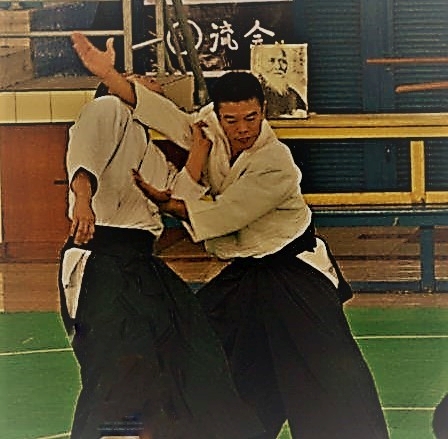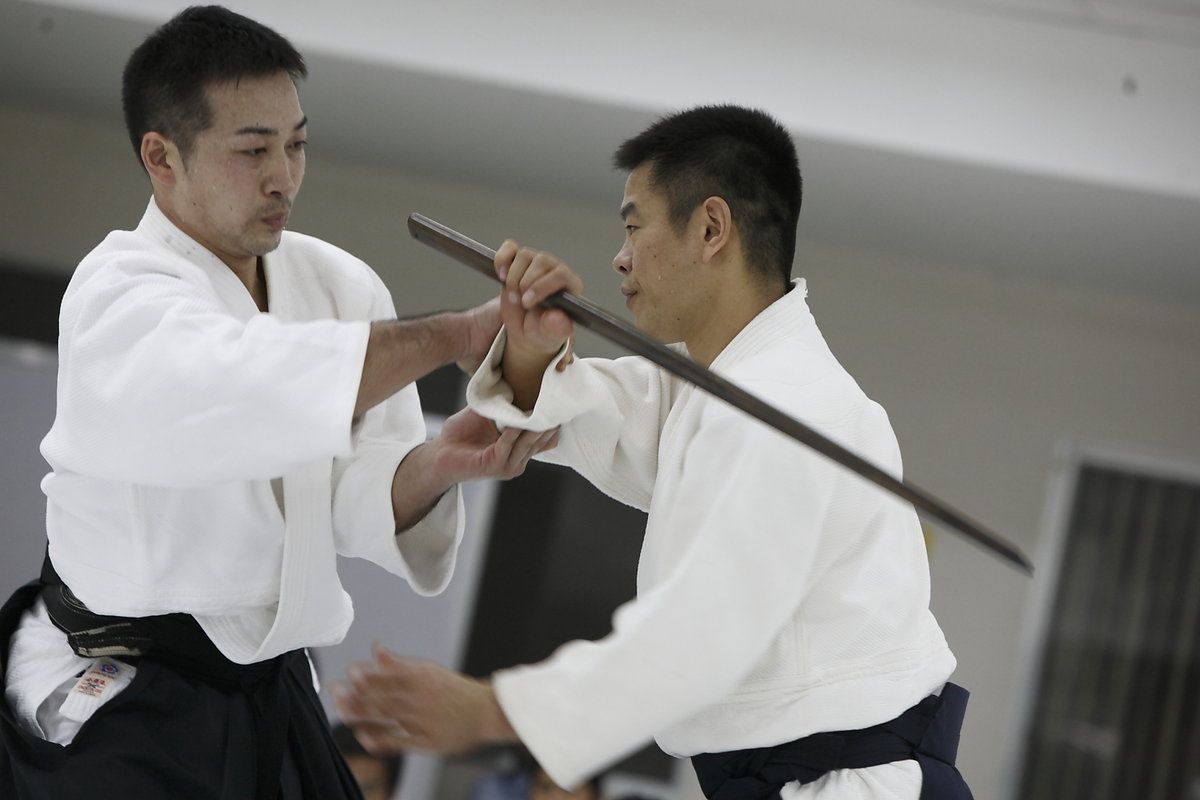Twenty years ago, Fujimaki Sensei brought a gift that sparked a breakthrough for Filipino aikidoists
Posted 2018 August 27

When aikido teachers seek to encourage struggling students, they urge patience and perseverance. They urge regular and intense training. They also warn that improvements will occur only in small, almost imperceptible ways. They tell us that breakthroughs occur very rarely.
This is the story of one such breakthrough, a breakthrough that single-handedly raised the game for my generation of aikidoists.
In 1998, Japan Aikikai and the Japan Foundation sent Hiroshi Fujimaki Sensei to Manila to conduct a 6-month aikido training course. Fujimaki sensei was just a little past 30, a shidoin, 4th dan, the lowest rank allowed to teach at Hombu Dojo.
During these six months, along with several other basic practices, he introduced his students to five distinct footwork exercises.
Throughout that last semester of 1998, he would start off each class by running his students through the five martial arts steps: okuri ashi, tsugi ashi, ayumi ashi, tenkan, and tentai. (These five steps are illustrated, each in isolation, in the clips at the end of this article.)
This was novel material in 1998. For years we’d heard the scolding exhortation, “Watch your footwork! Watch your footwork!” But this was the first time anyone ever trafficked in useful, usable detail about the how of footwork.
One of the steps – tenkan – was already well-known to us; beginners learn it at their first class. Another step – tsugi ashi – is a staple in kendo but was totally new and exotic to us.
The other three steps were not exactly new footwork; we had long been doing these steps in training, it was just that we had never thought to give them names until then.
At the time, these five steps did not feel like anything significant . They felt like just one more set of technical information to keep in mind. A chore, a not very engaging way to start a class.
And how do students behave when doing something they're not fully engaged with? They do it half-heartedly. Eyes glazed and minds elsewhere. With movements both slack and unfocused. No attempt at precision or crispness.
It doesn't take a high-ranked master to notice this, and so one day, as we zombied through the five steps, Fujimaki Sensei cried out, "Listen! This is a gift! This is my gift to you!"
A gift?
A pretty unusual way to describe a set of drills.
But it was a clear signal. A signal that the five steps were going to be a crucial element in our progress as aikidoists... if we had the imagination to see where these drills could lead.
Jolted by this not-so-gentle hint, some of us started paying attention. Practice and familiarity - and the implied promise of some greater significance encased in that word "gift" - gradually changed our attitude from indifference to respect for the five steps.
The first realization was stunningly basic: that giving names to phenomena is a stepping stone to understanding. For example, in the Judaeo-Christian creation myth, God brings the beasts and the birds to Adam to see what he would name them. Naming a thing or a phenomenon is the beginning of understanding, then of control, and then potentially of mastery, over it. And this is one reason why Judaism prohibits the casual uttering of God's name. The Jews consider that to write G*d's name, or to say it out loud, even in a non-irreverent way, is to begin a presumptuous quest to know, understand, and therefore master, Him - Him Who cannot be fully known, much less mastered, by His creatures.
By the same token, naming the five steps proved to be a quiet breakthrough. It sharpened our ability to perceive, and then to change behaviors. If an action remains unnamed, chances are it doesn't register on our consciousness. And if we're not even aware of an action, we certainly won't practice it deliberately. And without deliberate practice, we can't hope to master it.
For example, we had never recognized tsugi-ashi consciously as a distinct step until it had a name that we could note down, recognize in action, and discuss over beer. Until we had a name for it, tsugi-ashi seemed like an accidental blip in a dojo-mate's footwork, an unremarkable adjusting step in his effort to get a technique...done.
Same with tentai; before we had a name for it, we couldn't even see that step in the execution of a technique. It was just so fleeting. We were effectively blind to it. Or in the moments when we did notice tentai, we semi-awarely dismissed it as a debased version of tenkan.
But when we finally had names for tsugi-ashi and tentai - and okuri-ashi and ayumi-ashi too - we could begin to do what we had never done before: we could do them deliberately, rather than just accidentally. Or unwittingly. And we could refine the quality of their execution through repetition - doing them sharper, crisper, faster with each repetition.
And the second realization was again stunning: that there is a world of difference between approximating the sensei's movements - performing a "reasonable facsimile" - and actually replicating them.
The beginner's dilemma
When a new student starts aikido training, everything is bewildering. The movements are complex. The required mind-body coordination is daunting.
The student doesn’t know where to begin. And so he latches on to the obvious approach: watch and imitate.
But his attempts to mimic the teacher's movements are imperfect, because a) he hasn't earned the necessary muscle memory for the movements, and b) he has no visual vocabulary for recording and storing the many movements aikido uses.
 And so for the beginner, aikido is pure choreography: performing gestures that have little meaning for him, other than that the teacher has prescribed them. This stage is all about rote memorization – kabisote, in Tagalog slang.
And so for the beginner, aikido is pure choreography: performing gestures that have little meaning for him, other than that the teacher has prescribed them. This stage is all about rote memorization – kabisote, in Tagalog slang.Which is all fine. As long as the student doesn’t remain stuck at this stage. And that was precisely the problem: before July 1998, all of us remained stuck at the kabisote stage.
Kabisote meant stilted, lifeless movements. Kabisote meant presuming and expecting cooperation from uke, rather than authentic responses to the energy flows of attacks. Kabisote meant an unsophisticated, dumb wonderment at the dynamic movement of visiting aikido masters ... but very little understanding. “Amazing! How’d he do that?” - like a rube gaping at a circus act. Aikidoists who are at the kabisote stage simply fail to capture the exact movements that a sensei is showing.
And it’s crucial to capture the sensei's exact movements. It’s crucial because a particular way of executing a movement calls into play a distinct set of muscles, and contains subtleties that trigger distinct bodily sensations in the person performing the movements. And this is where learning occurs. This is where kinesthetic insights emerge.
Paradoxically, for a beginner, being kabisote is not a deplorable state; far from it. In fact it's necessary and inevitable. We all have to start somewhere. And across many arts and disciplines, imitation is a time-honored way for the apprentice to begin his learning journey.
But to be able to claim proficiency, long-time aikidoists had better be already beyond that mindset.
Substance, not just appearance
The reason the sensei wants us to replicate his movements exactly, and the reason we should want to do so, is that we want to experience the bodily sensations that the teacher himself feels when he does the movement, and that he wants us also to feel – mainly, exactly how energy is deployed, exactly how a balance-taking is effected in this current execution.
If you don’t do the movement exactly the way the sensei does it, if you are unable to do it, you don’t get to experience the same muscle group deployment, and the resulting bodily sensations, that the sensei wants you to experience. And when that happens, the sensei’s mental-and-kinesthetic insight sails right over your head.
What the five steps did was to give us a starting vocabulary for breaking down aikido’s complex movements into their component parts. And by being able to break down movements, we increased our chances of capturing the sensei’s exact pedagogic intent. (In 2012, the American sensei Donovan Waite gave a seminar in Quezon City. His most frequent exhortation, delivered in a soft-spoken undertone, was “Break it down! Break it down!”)
Therefore, by giving us the power to more accurately replicate teachers’ movements, the five steps helped us capture the substance, as opposed to just the appearance, of their movements. And not just of our teacher, but of any teacher. (Click here to see examples of the five steps being deployed in actual aikido techniques.)
Of course the five steps were just a starting point. After training for a long time, aikidoists come to realize that the art is about integrating a large handful of bodily and mental skills. Aside from footwork, there is also posture, stance, alignment, wrist/forearm rotation, relaxed shoulders, leg-centric power deployment, explosiveness, timing, angles of entry, rhythm, momentum, exploitation of the jointedness of the human body. And so on.
For our generation of aikidoists, Fujimaki Sensei, with his gift of the five steps, opened a gateway to these other elements of movement . - rsreyes